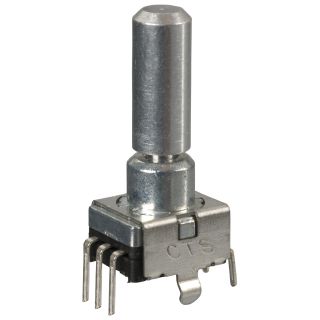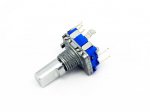The Pushbutton Rotary Encoder
After building several projects
with numerous
pushbuttons and switches I thought there had to be a better way to do
things. My original Pic-EL
had a rotary encoder but I never used it. I decided that a pushbutton
encoder and a LCD display could replace any number of buttons and
switches if a menu interface were used. Certainly a lot of amateur radio gear
today is designed that way; not everyone likes it but it is very
effective. So I went on DigiKey and searched for a rotary encoder. I
found the Grayhill 62P22-L4. It was
inexpensive and had the features I wanted. I made a few projects with
it, including the cable tester,
the electric blanket
controller, and the thermostat.
When I was building my appliance
timer,
I ran into a problem with the Greyhill encoder. If you wiggled the
shaft, it would generate spurious pulses to the software. I
replaced the encoder twice before I concluded that I must have a bad
batch of encoders. Certainly, my earlier projects did not have this
problem. I looked on DigiKey and found another pushbutton encoder,
a CTS series 290 rotary
encoder. The
CTS part number is 290VAB0R201B2
and the Digikey p/n is CT3007-ND.
 Unlike the Greyhill encoder, the CTS encoder has no
LED inside and consumes no power. The odd thing about the CTS encoder
is that for each rotary detent, it outputs all 4 codes instead of one
code as with the Grayhill. Once you figure this out and change the program
accordingly, the encoder works just
fine. As a bonus the shaft is a standard size making it much
easier to fit a knob.
Unlike the Greyhill encoder, the CTS encoder has no
LED inside and consumes no power. The odd thing about the CTS encoder
is that for each rotary detent, it outputs all 4 codes instead of one
code as with the Grayhill. Once you figure this out and change the program
accordingly, the encoder works just
fine. As a bonus the shaft is a standard size making it much
easier to fit a knob.
Rotary
encoders output different kinds of codes. The ones I have dealt with
output a 'quadrature 2-bit code' which tells you whether the shaft is
turning clockwise or counterclockwise. Check the spec sheet carefully.
I wrote an article
in August 2008 Nuts & Volts titled How to Use the
Pushbutton Rotary Encoder. The demo project used a
PIC16F84A with a Greyhill rotary encoder, a one-digit LED
display and a
buzzer. If you're looking for the project files, they can be downloaded
here. I would suggest using the CTS encoder, and all the
support code can be found in my appliance
timer project.
Update. QST Magazine published an article on rotary encoders in the June 2011 edition, Hands-On Radio Experiment 101 Rotary Encoders, which is more comprehensive than my article. There was a follow-up in the March 2012 edition, Technical Correspondence
column which adds even more more information. W2ORO uses the term
"pulses per detent" to describe what I observed with the Greyhill (1 pulse) and
CTS (4 pulses) devices. Interestingly, he also mentions a bad signal problem with
one manufacturer's part, just as I had experienced.
 Update
2. I found another inexpensive encoder similar to the CTS above. It is
made by Changzhou Xinze Electronic Co., and the model number is
EC11-1B-18T. It cost C$3.50 in 2012/04 (now C$1.00 in 2016-12). It can be panel mounted which is
nice, but does not come with a nut! My support code for the CTS encoder works with this encoder; for
an example see my Nokia Clock project. I purchased a few of them from iStore, in China (alas this web site is gone and I can't find this encoder anywhere now.)
Update
2. I found another inexpensive encoder similar to the CTS above. It is
made by Changzhou Xinze Electronic Co., and the model number is
EC11-1B-18T. It cost C$3.50 in 2012/04 (now C$1.00 in 2016-12). It can be panel mounted which is
nice, but does not come with a nut! My support code for the CTS encoder works with this encoder; for
an example see my Nokia Clock project. I purchased a few of them from iStore, in China (alas this web site is gone and I can't find this encoder anywhere now.)
VE3LNY's Electronics Notebook Page
 Unlike the Greyhill encoder, the CTS encoder has no
LED inside and consumes no power. The odd thing about the CTS encoder
is that for each rotary detent, it outputs all 4 codes instead of one
code as with the Grayhill. Once you figure this out and change the program
accordingly, the encoder works just
fine. As a bonus the shaft is a standard size making it much
easier to fit a knob.
Unlike the Greyhill encoder, the CTS encoder has no
LED inside and consumes no power. The odd thing about the CTS encoder
is that for each rotary detent, it outputs all 4 codes instead of one
code as with the Grayhill. Once you figure this out and change the program
accordingly, the encoder works just
fine. As a bonus the shaft is a standard size making it much
easier to fit a knob. Update
2. I found another inexpensive encoder similar to the CTS above. It is
made by Changzhou Xinze Electronic Co., and the model number is
EC11-1B-18T. It cost
Update
2. I found another inexpensive encoder similar to the CTS above. It is
made by Changzhou Xinze Electronic Co., and the model number is
EC11-1B-18T. It cost